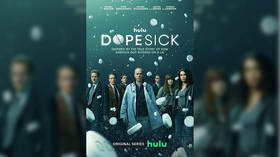In the age of vaccine mandates, opioid epidemic drama ‘Dopesick’ is very revealing on the mendacity and corruption of Big Pharma

New Hulu drama ‘Dopesick’ lays bare how those in business and government were prepared to callously harm regular folks for ungodly profits and unchallenged power. It’s a lesson worth learning given Big Pharma’s current influence.
‘Dopesick’, the new show about the opioid crisis on Hulu, has its flaws, but despite its shortcomings it’s most definitely must-see television.
The eight-episode series is compulsory viewing because in this age of vaccine mandates – when anything short of unabashed adoration of Big Pharma and government health agencies, as well as compulsive compliance with their edicts, leaves you ostracized from society – it lays bare the corrosive corruption of capitalism on “science” and exposes egregious government complicity with a pharmaceutical company that directly led to the tragedy of the opioid epidemic.
Also on rt.com Coronavirus A.30 variant ‘efficiently evades’ antibodies induced by Pfizer & AstraZeneca vaccines – lab study‘Dopesick’ is based upon Beth Macy’s non-fiction book of the same name. This, along with ‘Pain Killer: An Empire of Deceit and the Origin of America’s Opioid Epidemic’ by Barry Meier, ‘American Overdose: The Opioid Tragedy in Three Acts’ by Chris McGreal, and ‘Dreamland’ by Sam Quinones, should be mandatory reading for everyone who wants to understand the scope and scale of the crisis, as well as the sinister machinations that launched it.
The Hulu miniseries tells the story of the hell unleashed when OxyContin hit the market. The performances can sometimes be a bit uneven, and the show also does falter when it unnecessarily gets distracted with woke pandering on feminist and LGBT issues, but thankfully these irritants don’t diminish the vital tale of Big Pharma mendacity and government malfeasance at the heart of the story.
Some of the interesting stories featured include Dr. Finnix (Michael Keaton), a small-town doctor who gets seduced first by the drug company and then by the drug itself; and Betsy Mallum (Kaitlyn Dever), a working-class girl who became a slave to Oxy. Meanwhile, federal prosecutor Rick Mountcastle (Peter Sarsgaard) and DEA agent Bridget Meyer (Rosario Dawson) both swim against the tide as they try to hold Purdue Pharma accountable for the carnage it has unleashed.
Also dramatized are the wholly dysfunctional Sackler clan, owners of Purdue Pharma.
The Sacklers are a greedy and loathsome bunch. Arthur Sackler invented medical marketing back in the 1940s and ‘50s, and came up with valium as “mother’s little helper,” also creating a use for the drug to treat the ever-amorphous ailment of general anxiety.
Arthur’s nephew Richard Sackler (Michael Stuhlbarg) attempted much the same with OxyContin.
In the late 1980s, Purdue Pharma was in danger of losing its patent on MS Contin, a morphine pill for cancer patients that was the company’s main source of income. It would face financial calamity when cheaper generic versions of the drug hit the market.
It was in this desperation that OxyContin, a longer-lasting version of the opioid oxycodone, was born. The drug was introduced in 1996 and was aggressively promoted.
Purdue created dummy pain organizations and media outlets as its propaganda division to push the narrative of an “epidemic of untreated pain” ravaging America. These organizations, like the American Pain Society, lobbied the medical establishment to make pain the “fifth vital sign,” and succeeded.
Remarkably, Purdue then got the FDA to allow the company to put a label on OxyContin saying that danger of addiction was extremely low, despite no studies showing this claim to be true. In a stunning coincidence, the FDA official who granted this extraordinary label request, Curtis Wright, months later left the Food and Drug Administration to take a $400,000 job… at Purdue Pharma.
Purdue then unleashed its hyper-aggressive salesforce armed with the carrot of gifts, free meals and vacations, as well as the stick of lawsuits from patients if doctors didn’t prescribe Oxy. They visited medical offices specifically targeted by a database that focused on painkiller prescriptions, disability claims, and loose regulations.
The salesforce was also armed with a plethora of dubious marketing materials that claimed “less than 1%” of users become addicted to Oxy.
The sales staff referenced what has become known as the “Porter-Jick study” as proof of the “less than 1%” claim, and that became the cornerstone of the “pain treatment” movement and was even taught in medical schools across the country.
The stunning revelation about the Porter-Jick study is that it isn’t a study at all. It’s just the anecdotal observations of a crank doctor complaining in a five-sentence letter to the editor in the New England Journal of Medicine.
Purdue’s strategy only became more dubious and depraved as time wore on.
Oxy was supposed to work for 12 hours a dose, but for many people the effect didn’t last nearly that long. Purdue called this issue “breakthrough pain,” which sounds an awful lot like “breakthrough infections” in regard to Covid.
“Breakthrough pain” was treated by doubling the dose. When 10mg fails, you go to 20mg, then to 40mg, all the way up to the mother of all pills, the 160mg.
When addiction quickly followed, Purdue claimed that the signs and symptoms of addiction weren’t really addiction. Instead, it was an ailment called “pseudo-addiction,” and pseudo-addiction is really just untreated pain, so the only remedy for it is… you guessed it… more OxyContin.
The answer to everything was more OxyContin. And of course, with more Oxy comes more addiction, more death, more suffering, more despair, and more profits.
A similar paradigm seems to be in play regarding Covid vaccines. When they turn out not to be 100% effective, this results in calls for boosters, which in turn leads to more profit for Big Pharma. Like with the financial collapse of 2007/2008, failure can be remarkably profitable for big shots.
To be clear, I’m not advocating for or against vaccines, I’m advocating for critical thinking. The gullible and the goaded are fools to take the word of Big Pharma or government for gospel truth, be it about Covid, WMDs, or anything else – especially when profit and power can be gained by lying. As ‘Dopesick’ teaches us, the wisest approach is skepticism regarding the claims of Big Pharma and governments, and cynicism regarding their motives.
Ultimately, ‘Dopesick’ is a worthy watch because it tells the ugly truth about what the powerful are willing to do to regular folks, up to and including killing them, in order to make an ungodly profit.
Like this story? Share it with a friend!
The statements, views and opinions expressed in this column are solely those of the author and do not necessarily represent those of RT.














